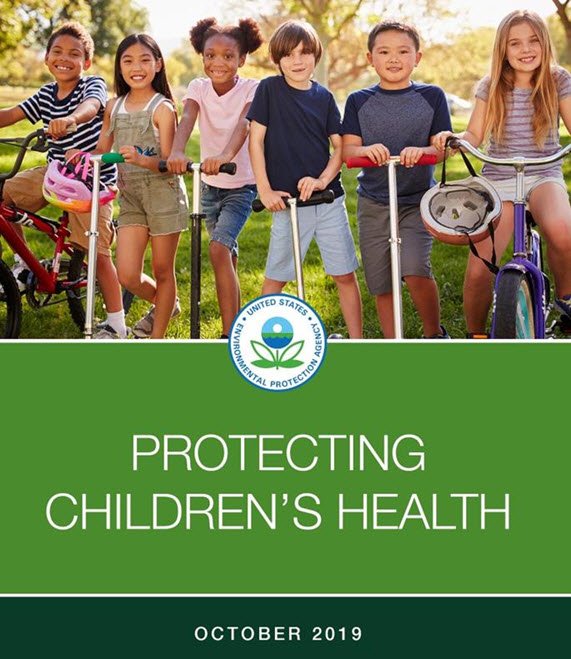EPA's 2019 Children’s Health Month Highlights
WASHINGTON (Oct. 31, 2019) - The U.S. Environmental Protection Agency (EPA) is celebrating the successful completion of Children's Health Month 2019 after conducting a number of key activities that support the agency's commitment to protecting children where they live, learn and play.
"I am proud of the work we continue to accomplish to protect children's health across the country," said EPA Administrator Andrew Wheeler. "From proposing the first revisions to the lead and copper rule in nearly three decades to announcing $10 million in funding to replace old school buses, the Trump Administration is making tremendous progress toward protecting the most vulnerable among us from environmental hazards."
Throughout the month, EPA officials hosted on-the-ground events celebrating Children's Health Month in all 10 regions. Key highlights from EPA's actions include:
Proposed Lead and Copper Rule
As part of Children's Health Month, EPA proposed an updated Lead and Copper Rule that significantly improves the actions that water systems must take to reduce lead in the nation's drinking water in Green Bay, Wisconsin. The agency's proposal takes a proactive and holistic approach to improving the current rule - from testing to treatment to telling the public about the levels and risks of lead in drinking water. When finalized, this proposal will:
- Require more water systems to act sooner to reduce lead levels and protect public health.
- Improve transparency and communication.
- Better protect children and the most at-risk communities.
Enforcement Actions
EPA announced 117 federal enforcement actions completed over the last year to ensure entities like renovation contractors, landlords and property managers are in compliance with regulations that require them to protect communities and the public from exposures to lead.
Partnership to Reduce Childhood Lead Exposure at Schools and Childcare Facilities
EPA signed a new Memorandum of Understanding (MOU) that provides a framework for a coordinated approach between more than a dozen critical partners across the federal government, tribes, water utilities and the public health community. The commitments of the MOU support the Lead Action Plan, which provides a blueprint for reducing lead exposure and associated harms by working with a range of stakeholders, including states, tribes and local communities, along with businesses, property owners and parents.
One existing effort that is further supported by this MOU is EPA's 3Ts - training, testing and taking action - for Reducing Lead in Drinking Water in School and Child Care Facilities.
DERA Grants
In FY 2019, EPA awarded more than $9 million in DERA funding for rebates to replace older diesel school buses with newer, cleaner vehicles. This month, EPA announced the availability of approximately $10 million in rebates to public school bus fleet owners to help them replace older school buses.
School buses travel over 4 billion miles each year, providing the safest transportation to and from school for more than 25 million American children every day. However, exhaust from diesel buses can harm health, especially in children, who have a faster breathing rate than adults and whose lungs are not yet fully developed. EPA has implemented standards to make newer diesel engines more than 90% cleaner, but many older diesel school buses are still operating. These older diesel engines emit large amounts of pollutants, including particulate matter, which is linked to instances of aggravated asthma, lung damage and other serious health problems.
Children's Health Resources and Reports
Over the past month, EPA released the following reports:
- Protecting Children's Health, October 2019 Report: The report highlights major local and national initiatives and accomplishments to promote children's health and healthy learning environments.
- Progress Report on the Federal Action Plan to Reduce Childhood Lead Exposures and Associated Health Impacts (Progress Report): The Progress Report outlines key EPA actions that have been made since December 2018 to address these commitments as outlined in the Federal Lead Action Plan to Reduce Childhood Lead Exposures and Associated Health Impacts.
- Supporting Healthy Houses of Worship: Effective, Affordable Measures to Protect the Health of Congregations and Staff booklet: This booklet is designed to provide places of worship with information on actions they can take to reduce environmental health risks, with a special emphasis on children's health, as children are particularly vulnerable to many environmental risks.
- Updated 2019 America's Children and the Environment Indicators Report and corresponding booklet: This booklet highlights a selection of the indicators that were updated in 2019 with newly available data.

Additional Resources
To learn more about the Proposed Updated to the Lead and Copper Rule, visit: www.epa.gov/ground-water-and-drinking-water/proposed-revisions-lead-and-copper-rule.
A full list of EPA's lead-based paint enforcement actions is available at: https://www.epa.gov/enforcement/epas-lead-based-paint-enforcement-helps-protect-children-and-vulnerable-communities.
To read the Partnership to Reduce Childhood Lead Exposure at Schools and Child Care Facilities MOU and related information visit: https://www.epa.gov/safewater/3Ts.
To view the Protecting Children's Health, October 2019 report: https://www.epa.gov/children/protecting-childrens-health-october-2019-booklet.
To view the Progress Report on the Federal Action Plan to Reduce Childhood Lead Exposures and Associated Health Impacts, visit: https://www.epa.gov/leadactionplanimplementation/progress-report-federal-action-plan-reduce-childhood-lead-exposures-and.
To view the Supporting Healthy Houses of Worship: Effective, Affordable Measures to Protect the Health of Congregations and Staff, visit: https://www.epa.gov/newsreleases/epa-releases-new-booklet-help-houses-worship-identify-and-reduce-environmental-health.
To view the America's Children and the Environment October 2019 booklet: https://www.epa.gov/americaschildrenenvironment/americas-children-and-environment-october-2019.
To view the full set of America's Children and the Environment indicators: https://www.epa.gov/americaschildrenenvironment.
To learn more about what EPA is doing to protect children's health, visit: https://www.epa.gov/children.

